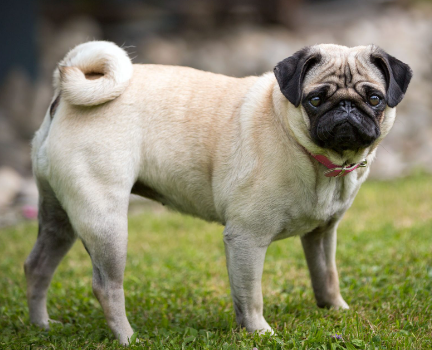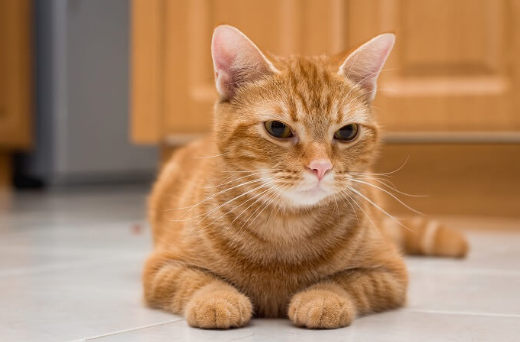The American Bobtail, an unconventional domestic cat breed, originated in the late 1960s and is distinguished primarily by its distinctive “bobbed” tail, measuring approximately one-third to one-half the length of a typical cat’s tail. This unique feature results from a genetic mutation affecting tail development, akin to the genetic anomaly observed in the Manx cat.
Despite the shared name and physical characteristics, the American Bobtail is unrelated to the Japanese bobtail. The breeding programs for these two breeds are entirely independent, and the genetic mutation responsible for the bobbed tail in the American Bobtail differs from that of the Japanese bobtail. Notably, the mutation causing the American Bobtail’s tail is dominant, while the Japanese bobtail tail mutation is recessive.
Known for their robustness, American Bobtails come in both short and long hair coats, characterized by a shaggy texture rather than being dense or fluffy. These cats can exhibit a variety of eye and coat colors, with a particular emphasis on achieving a visually striking “wild” tabby appearance in observable individuals.
- ORIGIN: United States
- HEIGHT: 9–10 inches
- WEIGHT: 7–16 pounds
- SIZE: Medium to Large
- LIFE SPAN: 13–15 years
- COLORS: White, black, blue, red, cream, chocolate, lavender, cinnamon, fawn, plus various patterns and shadings
American Bobtail Characteristics
American Bobtails make excellent companions for a wide range of individuals and living arrangements. These resilient and sizable cats effortlessly integrate into family settings with children or other pets, forming strong connections with single individuals as well.
Due to their sociable and approachable demeanor, even towards strangers, American Bobtails are frequently chosen as therapy cats.
Requiring only a moderate level of exercise, they thrive in smaller homes and have shown an affinity for a mobile lifestyle, accompanying truckers, RVers, and sailors with evident contentment!
| Playfulness: 4 | Grooming Effort: 1 |
| Intelligence: 5 | Pet-Friendly: 5 |
| Energy Level: 3 | Shedding: 4 |
| Health Issues: 1 | Kid-Friendly: 3 |
| Affection Level: 5 | Chattiness: 3 |

History
The American Bobtail remained relatively unnoticed until recent times, surprising many to discover its presence in North America dating back to the 1960s. Despite its unassuming beginnings, the American bobtail is gradually gaining recognition.
The progenitor of this breed was Yodi, a short-tailed brown tabby male discovered in an Arizona motel after being left there by a child from a nearby reservation. Yodi’s lineage was uncertain, and rumors circulated that he might be a hybrid of a bobcat and a domestic cat due to his feral appearance and a short, bobcat-like tail.
While it is feasible for domestic cats to mate with bobcats, such hybrids, especially first-generation males, are typically sterile. In Yodi’s case, it is more plausible that his abbreviated tail resulted from a spontaneous mutation within the domestic cat population.
Charmed by Yodi’s amiable demeanor and distinctive tail, a couple on vacation at the motel adopted him. Upon bringing Yodi home, he mated with the family’s Seal Point Siamese.
The initial litter included both normal-tailed and bobtailed kittens, indicating that the gene governing Yodi’s bobbed tail was dominant. The Siamese had no history of short-tailed ancestors, suggesting that only one copy of the dominant gene was needed for the trait to manifest in the offspring. Consequently, the breed was named the American Bobtail.
The early lines descended from Yodi became inbred and faced health issues. The focus then shifted towards enhancing the breed’s health and maintaining the Yodi-like characteristics: a large, wild-looking tabby with long hair and a bobbed tail. Healthy cats of this breed feature rounded brows from forehead to eyelid, contributing to a distinctive “hunting look” that enhances their feral appearance.
American associations
The American Bobtail has garnered recognition from four North American associations. The revamped American Bobtail exhibits a diverse range of colors and patterns while embodying the sweet temperament coupled with the untamed appearance reminiscent of a bobcat. This breed boasts both long and short coats.
Appearance
The development of American Bobtails spans two to three years, a slower pace compared to many other domestic cat breeds.
Characterized by robustness, the American Bobtail is a compact, short-tailed cat with a moderately long, sturdy body. The overall physique tends toward a substantially rectangular shape, featuring a full and broad torso.
The hips are noteworthy, nearly as wide as the chest, and the hind legs surpass the front legs in length, culminating in large rounded feet, possibly adorned with toe tufts. The head takes the form of a wide wedge, lacking flat planes, proportionate to the body size.
A concave curve extends from the nose to the brow, or rises to a prominent brow, complemented by a broad, unpinched muzzle, pronounced whisker pads, a gently sloping broad nose, and a robust, full jaw.
Medium-sized ears, broad-based and evenly positioned, adorn the top and sides of the head with rounded tips. The nearly almond-shaped eyes, proportional to the head, exhibit an angle towards the base of the ear, a moderately wide gap, and deep sockets.
Eye color correlates with the coat color. The tail’s tip is visible above the back, not extending beyond the hock at rest. The tail may possess a straight or curved form, with a slight knot or bumpiness.
American Bobtail Temperament
American Bobtails are frequently characterized as affectionate, gentle, and easygoing. These feline companions excel as lap cats and make wonderful additions to households with older children and other cat-friendly playmates.
Renowned for their dog-like behaviors, Sarah Wooten, DVM, notes, “American Bobtails are known to exhibit more canine traits than feline ones. They are highly sociable, friendly, inquisitive, good with children, possess a diverse range of vocal expressions, and form deep connections with their human counterparts.”
Displaying intelligence, American Bobtails require mental and physical stimulation to stay engaged. It’s not uncommon for them to express themselves with chirps and trills, indicating their desire for one-on-one playtime.
Prospective owners should be ready to offer a substantial level of enrichment, including climbing opportunities, interactive play sessions, food puzzles, toys, training activities, ample human interaction, and even leash walking, according to Wooten. These cats demand attention and exercise comparable to that of a healthy, young beagle.
Above all, the American Bobtail desires to share and receive love. If you seek a gentle companion pet, this breed proves to be an excellent choice. Their amiable nature makes them particularly well-suited for families.
American Bobtail Personality
The American Bobtail may possess a wild appearance, but its nature is far from untamed. This breed has garnered a devoted following due to its dedicated, loving, and intelligent personality. These confident and friendly cats form strong emotional bonds with their families, quickly adapting to various home environments.
While not as vocal as some breeds like the Siamese, Bobtails express their emotions unmistakably. Playful, energetic, and amicable, they showcase remarkable intelligence, sometimes exhibiting Houdini-like escapes from closed rooms and locked doors. With a strong affinity for people, they draw attention through meows or by claiming available laps.
On the feline activity scale, Bobtails are characterized as fun-loving and frisky, striking a balance between playfulness and moderate activity. Typically, they coexist harmoniously with other cats and cat-friendly dogs when introduced properly. Instead of retreating under furniture, they display curiosity and outgoing behavior when unfamiliar visitors arrive. Early training often results in their being excellent travelers.
Health
While American Bobtails are generally robust, they, like other cat breeds, are susceptible to developing health conditions. According to our claims data, the predominant health issues for American Bobtails encompass:
- Weight loss
- Diabetes
- Hyperthyroidism
- Kidney disease
- Ear infection
Additionally, veterinarians have observed that American Bobtails born without tails may face an increased risk of back and intestinal irregularities.
While these conditions are prevalent in American Bobtails, it’s not guaranteed that your cat will experience any or all of these problems. Becoming acquainted with the signs of these issues can be advantageous. However, one of the most effective ways to ensure your pet’s well-being is to schedule an annual visit with their veterinarian.
Even if your cat appears perfectly healthy, regular checkups are crucial. Cats often conceal signs of illness, making it challenging to discern their well-being solely by observation. Regular annual visits enhance the likelihood that your veterinarian can detect and address potential health issues at an earlier stage.

American bobtail Care
Maintaining your American Bobtail’s grooming needs is relatively straightforward. Regular brushing, typically once or twice a week, ensures their coat remains sleek and healthy. Additionally, it’s essential to trim their nails regularly and attend to ear cleaning. According to Wooten, brushing the American Bobtail twice a week is advisable.
Given their high intelligence, these cats are generally receptive to training for basic tasks like using the litter box or scratching posts. They can also learn more advanced tricks, such as playing fetch and walking on a harness, provided they are mentally stimulated with interactive toys.
Socializing with this easy-going breed is usually uncomplicated. American Bobtails introduced to people and other pets tend to warmly welcome unfamiliar faces.
A well-balanced diet of high-quality cat food, as recommended by your veterinarian, is crucial for your American Bobtail’s health. Exercise caution to avoid overfeeding, as it can lead to obesity.
Best Food For
American Bobtails typically do well on a high-quality adult cat food diet. If you have a Bobtail requiring assistance with weight management, the Healthy Weight Formula is worth considering.
For American Bobtail kittens, it is recommended to provide kitten food during the first year of their lives to support optimal growth and development.
Feeding
Determining the appropriate food quantity for your American Bobtail depends on several factors that might not be immediately apparent. Factors such as whether the cat is an indoor or outdoor pet and whether they have undergone sterilization surgery play a pivotal role in establishing their dietary requirements. It is essential to seek guidance from your veterinarian, who can assess your American Bobtail’s ideal weight and daily calorie needs. Take the initiative to discuss your cat’s weight and diet with your veterinarian.
Once you have the recommended quantity for your American Bobtail, rest assured that providing this amount is vital for maintaining a healthy weight. Preventing obesity is easier than helping an overweight American Bobtail shed excess pounds. The next step involves arranging your cat’s meals.
American Bobtails typically prefer smaller, frequent meals throughout the day. It’s advisable to have a bowl available for them to graze as needed. Alternatively, you can portion their meals for better control, offering half in the morning and the remaining half in the evening. While it may be tempting to indulge your American Bobtail with treats, do so sparingly to avoid compromising their nutritional balance. Be cautious not to let snacks contribute excessively to their salt intake, akin to the considerations for human dietary habits.
Grooming
American Bobtails are cats with relatively low maintenance requirements. Brushing your Bobtail once or twice a week is generally sufficient to eliminate shedding hair, promote skin health, and keep their coat glossy. During seasonal changes, particularly twice a year, Bobtails may experience increased shedding, necessitating more frequent brushing during these periods.
To prevent periodontal disease, it is crucial to prioritize dental hygiene in any cat breed, including the Bobtail. Regularly brushing your Bobtail’s teeth, at least once a week, is essential for optimal oral health. While treats designed to control plaque can be a beneficial supplement, they should not be the sole method of maintaining your cat’s dental hygiene.
Training
Ensuring mental stimulation is crucial for the contentment of your American Bobtail. These cats thrive on engaging in activities such as puzzle games, trick training, and leash training.
Exercise
American Bobtail cats exhibit high levels of activity and playfulness. Their inquisitive nature leads them to thoroughly enjoy games, play sessions, and vigorous climbing. If you’ve desired a cat that actively engages with humans and the idea of walking your feline companion on a leash appeals to you, the American Bobtail might be the perfect breed.
It is advisable to provide your cat with a high-quality climbing tower, a window perch, multiple scratching posts, and a variety of toys. Opt for toys with shiny surfaces, as they often become favorites for these spirited cats.
Where to Adopt or Buy an American Bobtail
Locating a reputable breeder for the relatively rare American Bobtail cat breed in the United States can be challenging. The American Cat Fanciers Association currently lists only two breeders, one in North Dakota and the other in Wisconsin.
Explore local cat breeders and online networks to identify breeders with established reputations and positive reviews. Alternatively, if registration is not a top priority, adoption sites offer the opportunity to find a bobtailed cat that resonates with you.
See More Cat Breeds For Further Research
FAQs
American Bobtail Price in India:
The cost of American Bobtail Cats in India typically ranges between Rs. 60,000 and Rs. 80,000, particularly when obtained from a highly reputable source.
Are American Bobtails Good Cats?
Despite their somewhat wild appearance, American Bobtails prove to be dedicated companion cats that seamlessly integrate into families. With a sociable and easy-going nature, they coexist harmoniously with children and other four-legged companions. Their confidence and friendliness, coupled with high intelligence and dog-like personalities, make them excellent pets.
Do American Bobtail Cats Meow?
American Bobtails are generally quiet cats. While they may exhibit chirping, trilling, or clicking sounds when excited, their overall demeanor tends to be calm.
Are American Bobtail Cats Part Bobcats?
Contrary to urban legends, American Bobtails are not the result of crossbreeding between domestic tabby cats and wild bobcats. The distinctive tail of the American Bobtail arises from a spontaneous genetic mutation in the domestic cat population. This mutation may have some connection to the Manx gene, which is also dominant.
What’s the Rarest Cat Breed?
According to the UK’s Governing Council of the Cat Fancy (GCCF), the Sokoke cat holds the title of the rarest domestic cat breed in the world.












4 thoughts on “American Bobtail: Know About Pat Full Information…”